Scouting about...
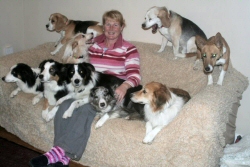 In
the first in a series of articles about some of our most successful handlers and their dogs,
Soraya Porter talks to some of our most high profile handlers about competing at the top of our
favourite sport and how hard they have to work, not only to get there, but to stay there. It
might surprise you to know that they are not all confident, all knowing. Instead many admit
they're still learning, and say they're still quaking in their boots along with the rest of us!
What better way to kick off the series than with an interview with Wendy (Fairlamb) Clay whose
dog Scout Soraya seriously covets! In
the first in a series of articles about some of our most successful handlers and their dogs,
Soraya Porter talks to some of our most high profile handlers about competing at the top of our
favourite sport and how hard they have to work, not only to get there, but to stay there. It
might surprise you to know that they are not all confident, all knowing. Instead many admit
they're still learning, and say they're still quaking in their boots along with the rest of us!
What better way to kick off the series than with an interview with Wendy (Fairlamb) Clay whose
dog Scout Soraya seriously covets!
Soraya:
When and how did you first get into agility?
I started
Agility in 1990 when I went to look at the classes because Mike had just started going and came
to Obedience every week, going on about how good it was. The classes were held at a kennels in
Northamptonshire and run by Milton Keynes DTC. The trainers at that time were Diane Griffin,
Jane Gold and Janet Jordan.
|
Soraya: Tell us about your first
dog.
Wendy: I started with two dogs, Zany and Hattie. Zany, a white and black WSD was aged
seven years when she started. She was amazingly clever and very temperamental but still
managed to win me out of Starters, although never getting that second win to go Senior.
Hattie, a tri-colour Beagle - some things never change then - started at 12 months and
made it to Advanced but was retired before Champ classes started.
Soraya: Tell us about some of
your early training problems.
Wendy: I never really had any problems with either dog other than Zany who was very
left handed as I had taught and competed her in Obedience. I have several old and very
embarrassing videos of me and Zany running whole courses all on the left. Her weaves were
fairly steady as she was taught push pull, which I vowed never to teach another dog. |

First agility dogs - Hatter & Zany |
Hattie's
major problem was that she had to compete at 2'6'' as there were very few Mini (small) classes
then. She could jump the height, but I was never happy about her jumping so high on a regular
basis. Let's face it. If there was a steak or a smelly dustbin the other side, she would
have done it with ease! At that time, there was a national qualifier (Spillers I think), which
was set at 2', and Hattie loved those. It wasn't too long before shows started to put on
classes for the smaller dogs so once she was jumping an lower height she excelled.
Things
have changed so much since I started doing Agility. The best change as far as I am concerned is
the use of V-weaves which I prefer, weave bows and channel weaves. It's only my opinion but I
just can't understand why anyone would still want to teach weaves on straight poles only.
|
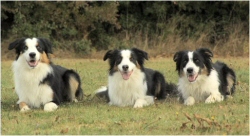
Tishi, Nuggett & Callum |
Soraya: Can you tell us a bit
about your current dogs?
Wendy: Tishi is a wonderful 7 1/2 year old tri-colour WSD who
is Large Grade 6. She is a absolute star and always gives me 100%. She has qualified for
loads of finals and, although I know she doesn't have the speed to win them, she always
does her best and always gets a clear round. She is not showing any signs of slowing down
and seems stronger and quicker every year. She is like running a dog on rails.
Scout - a red head with a temper similar to my own - is a 3 1/2 year old JRT x WSD who is
Small Grade 7. He is awesome to run - fast, powerful, clever and opinionated. We've had
the most amazing year. |
He has
had 28 KC wins this year, has won a Championship class and has been reserve in another with
Brad Moyler. He has also qualified for Olympia and Crufts - KC singles and Championship class,
Eukanuba Knock Out and Challenge - and won the Small Supadog Agility Dog of the Year. He has
been invited to compete at the KC team selection for the European cup and is a member of the
UKA World cup team, which is being held in Belgium next year.
My other
two dogs have been hi-jacked by Mike!
Tishi's
son Nugget is a 5 year old tri-colour WSD Large grade 5. Mike started running Nugg when his own
dog was injured and then qualified him for the Novice Olympia final so he has continued to run
him to give him a chance to get a good bond for Olympia. They have since won quite a few
jumping classes this year.
|
Michelle, a tri-colour Beagle, is just over two years old. She is great and has real
attitude. I miss running her, but I made the decision to let Mike work her as I wanted to
concentrate on qualifying Scout for the UKA World Cup team. Mike is obviously doing a
good job as she has won three classes in the last two weeks so she will start next year
as a Small Grade 4.
I
do most of our dogs' training as I work from home. We are very lucky in that all our dogs
will run with each other so they don't miss out if one of us can't go to a show.
Soraya: What size dogs do you
run, and why?
Wendy: Large and small. I don't see dogs in sizes. I see them as dogs. Does that make
sense? Whatever size or breed of dog comes to me to live or for training, I am happy to
give it a go at Agility.
Soraya: Do you think that people think it is
easier to be successful with a Small dog, and do you agree with them? |
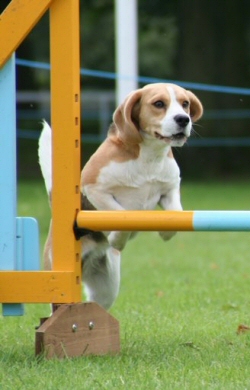
Michelle |
Wendy:
In a word YES. I think they do! Lots of people seem to think that Small dogs should have
smaller contact areas as small dogs cannot miss contacts. Hah! They should try watching a Small
agility ring. There are just as many missed contacts as there are in Large dog classes! There
is no difference training a Small dog to a Large one. To get to the top with a Small dog you
still have to train tight turns, send aways, fast contacts, pull throughs etc. etc. and you
have to be able to train those things to be as better than the rest of the dogs in your class
if you want to be successful.
With this
present grading system, I think it will initially be easier to be successful with a Small dog
simply because, at the moment, the lower classes have very small entries so dogs have less to
compete against. However, once they progress to Grade 3, they have the same hurdles to climb as
the Large dogs as the classes get bigger and the competition faster.
I have
always thought that many Small dog competitors were fantastic handlers because traditionally
the classes were Opens so they were always in queues watching Champ level handlers work the
course and, therefore, learning by watching. I do think it is only fair that the Small dogs
are, at last, being treated as equals and getting graded classes of their own.
Soraya: What got you really hooked on
agility, and who were your biggest influences and mentors?
Wendy:
I was hooked from the first lesson.
Lisa
Gantly was at MKDTC when I started. She was a great mentor as we ran pairs together, and she
helped my training and motivation. She was always there to offer advice with course walking and
anything I wanted to learn, always encouraging me to push my dogs and myself to the limit.
I'm not
sure about influence or mentor but Mike has been great, too. He never knows where we are going,
just gets in the vehicle and drives! We have travelled all over the country including taking an
Agility holiday to the Isle of Man. He moans about getting up at 3.30am but then, who doesn't?
|
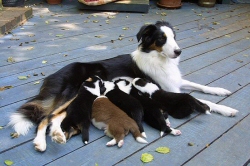
Tishi and her puppies |
The
biggest influences on my handling when I started I suppose were people who were at the
top - Don Cooper, Fran Graham, Keith Rump and Eleanor Balchin to name a few. I loved the
partnerships that Don had with Daley and Fran had with Cap. In fact, that was one of the
reasons I brought Tishi as she is from Cap's line and why I chose to use Sue and Charlie
Wyatt's dog, Trio, when I was looking for a dog to father her puppies. Both Tishi and
Nuggett have the same working heads of those lines which I love in a dog.
Eleanor and Keith were working at the top of Mini agility when I started. Eleanor's
Papillion's were fast and accurate, and she handled them so skilfully around a course.
Keith had a dog in an amazing dog in a million with Timmy, a JRT who was driven and
powerful. When Tim and Keith got it right, they were very often unbeatable.
Soraya: Who or what would you say
were your biggest influences now? |
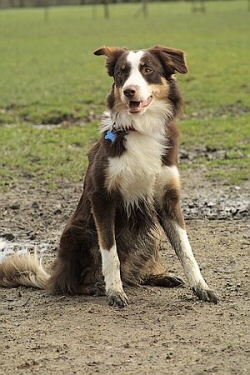
Proud Dad Trio |
Wendy:
Since moving to Lincolnshire four years ago, I do most of my training on my own so I really
enjoy and appreciate attending training days when I get the chance. I've been on two courses
this year, the first was with Den Keeler which was great as he set up tricky exercises which
made me think and picked me up on some of the lazy things I do. The other with Lisa Gantly and
Carla Whyte, I love training with Lisa because she handles from behind, the same as I do so
understands the need to give clear directions and more importantly when to do it! Carla was
good at picking up on body language and humoured me when I had a "toys out of the pram" moment
because
I
couldn't do something right.
I love
training with Toni Dawkins because Minx and Scout work very alike so she helps with tightening
Scouts turns.
The
biggest influence in Scouts early contact training was Jo Rhodes. I knew I wanted to teach him
to target the contacts and had taught him on the flat but didn't know how to join it up with
the contacts. Jo explained how to go about it and the rest as they say is history.
The
person who I train with most often is Brad Moyler who is very calm and makes me realise
sometimes I ask Scout for too much without giving him enough information.
Soraya: When did you realise you were
getting quite serious about competitions?
Wendy:
My Dad is very competitive so I've always played sports to win, so as soon as I did my first
lesson I knew I wanted to go to shows and do as well as I could and hopefully win.
Soraya: Is there anything that you know now, that you
wish you'd known when you first started to get more involved in agility?
Wendy:
Using targets on the contacts and for send aways.
Making
sure to warm yourself and your dog up properly with exercise and massage.
Soraya: Do you suffer from competition
nerves, and if you do, how do you cope with them?
|
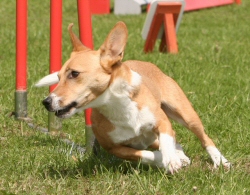
Scout doing what he likes best
Photo: Alan Score |
Wendy: Yes I do. It's a side affect of running Scout!! The only trouble with running
such a brilliant dog is that when you put him on that start line you know if you give him
the correct information he could win the class but that also puts the pressure on me to
get it right for him.
I'm
not sure I do cope with my nerves... Better ask anyone who's unlucky enough to be
standing near me. I
mostly just try not to throw up.
Soraya: Do
you have a particular routine you follow when you're competing?
Wendy: Yes I do. I always go around the course in my head whilst in the queue. |
With
Tishi, I do turns on the spot in both directions and a quick massage to keep her warm and let
her watch the other dogs running as it puts her in the zone. With Scout, I also do a few turns
but not many as he locks onto my hands and gets too wound up. I do some hand targets to get him
to tune into me and a couple of target touches. He gets a pre-run massage, too. All my dogs
work for titbits and toys, and I reward them with food when they finish their runs. If it's
an Agility round, they always have to go into the contact target position to get the food. It's
my way of rewarding the behaviour they gave me whilst they were in the ring.
Soraya: Do you prepare yourself and
your dog differently if it's a competition final?
Wendy:
I go through the same routine as if it's a normal run but have to try even harder not to throw
up!
|
Soraya: People watching an
experienced handler comment on how they make it look so easy. Would you say you were
still learning, and do you have any major issues you are working on at the moment?
Wendy: I believe that if you think you know it all, that's when you should stop. You
should never stop learning. I'm sure there are loads of people on the circuit who could
teach me lots of ways to improve my handling.
I
don't have any major issues both of my dogs are great to work. Tishi loves tricky courses
where she has to turn herself inside out to get around so, if I'm in the right place, she
is easy. Scout is so driven and powerful that I will always have to keep training his
turns. He is also much quicker than me so I can easily loose him on a straight run but
that's part of the thrill of running him. |
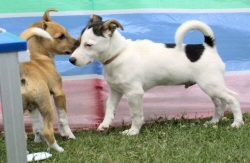
Scout & his brother Troy |
Soraya: Do you have a top training
tip?
Wendy:
Be consistent.
Soraya: What advice would you give to
someone who is just starting out in the competitive circuit, who would love to eventually get
to Crufts, Olympia or any of the major Finals?
Wendy:
Again, be consistent and make it fun. Listen to everything you are told. You don't have to do
what everyone tells you, but their advice may be good and, if you don't listen, you may miss
out. Above all, remember your dog is your pet. Win or loose you get to take the best dog home -
a bit twee I know but it's true.
Be
realistic, you may want to win Olympia, but your dog may not have the same aims in life. Ask my
Portuguese Podengo if he'd rather win or sleep. No, don't bother. Anyone who's met Moca will
know the answer. I believe anything is worth trying for but don't - not at all costs - try to
be the best Grade 1 in a Combined 1-3 class and see where that leads you.
I'm as
guilty as the next person of thinking my dog should have known better or accusing them of just
ignoring me, but experience has taught me that dogs are not machines. They only do what we cue
them to do, so look at yourself before you blame the dog!
Soraya: Do you set yourself goals, and
if you do, can you tell us any you have set for the 2008 Season?
Wendy:
Yes, I do and I encourage everyone who I train to do it as well, even if it's jumping four
jumps in a row. It's important to see how well you are progressing. I'm still on this year's
goals at the moment, the obvious one being don't throw up at Olympia, to enjoy the experience
and do my best.
I guess
next year will be similar to this years.
-
Try to
qualify for Olympia and Crufts again.
-
Hope
Scout doesn't have a nervous breakdown when we get to Crufts in 2008.
Representing my country will be the most amazing thing I will ever do so the World Cup will be
a huge goal for next year. I'm so proud of Scout for qualifying and just hope I don't let Greg
and the rest of the team down. I will try my hardest, and that's the best you can do.
Soraya: What is your favourite thing about Agility and
why?
Wendy:
There are lots of things I love about Agility but above all, I think it's the dogs and people.
I'm not a naturally confident person and tend to be stand offish at times until I get to know
someone, but I love meeting up with people from all over the country who come together to do
something fun and responsible with their pets. This includes all the people who come to me for
training.
Teaching Agility is my
favourite
thing. It gives me a real buzz. Unfortunately someone recently tried to destroy my passion for
teaching, but I am lucky enough to have some fantastic friends to whom I am eternally grateful
- you know who you are. Without them, I would have given it all up. I am so glad I didn't
as its amazing to watch a partnership grow and learn. Seeing the smile on my pupils faces when
they get something right is like winning the lottery for me.
Thanks to
Soraya for asking me to do this interview.
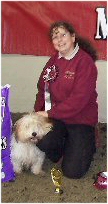 About
the author... About
the author...
Soraya
Porter lives in the smallest town in England - Manningtree, sharing her house with three
Siamese cats and her dog Ernest (Hartsfern In Earnest) who also can be heard answering to the
names of Ernie, Ern, Monster, Beast and Fish Face! Ernie runs at Grade 7, and has had many
appearances at Crufts, where he is in great demand to pose for photographs with Japanese
tourists!
Currently she trains at Colchester Dog Agility
Club and Valley Farm Agility Club, as well as doing some freelance teaching, the odd judging
appointment, designing simple agility websites, and hand spinning dog fibre. Given such
ingrained insanity, itís a miracle that Ernie has taken part in as many Finals as he has.
|